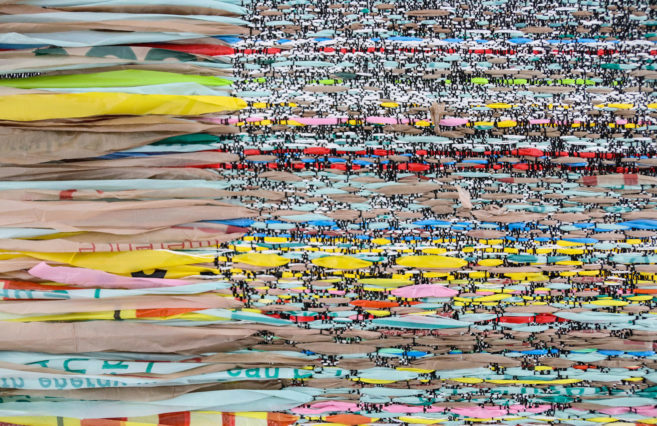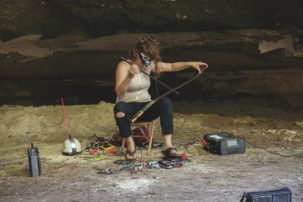The disciplines of art and physics share certain critical perspectives: both deal with how metaphor and analogy inform creative processes. Additionally, artists and physicists address issues of the imagination, creative thinking and communication, and how meaning is made through theoretical research and process-based investigations. There are also important differences in these perspectives. Art brings an appreciation for abstract or non-representational practices. Physics research addresses complex problems relevant to understanding the study of matter and motion through space and time. Physicists also contribute knowledge about how the universe behaves. Together, the achievements of art and physics allow the possibility of a much richer understanding of the nature of reality than each field can contribute individually.
This is the premise from which we began Leaning Out of Windows (LOoW). Titled after a German expression for interdisciplinarity—“aus dem Fenster lehnen,” which we learned from our collaborators Margit Schild and Elvira Hufschmid, and which roughly translates to “leaning out of the window”—it’s a project that researches creation itself. LOoW explores how artists and scientists form shared interpretations and how knowledge can be translated across disciplinary communities. Supported by a Social Sciences and Humanities Research Council Insight Grant, the project coordinates, curates and analyzes models of collaboration between Emily Carr University of Art and Design and TRIUMF, Canada’s particle accelerator centre. TRIUMF, located at the University of British Columbia, is owned by a consortium of 20 Canadian universities. It houses a cyclotron, a particle accelerator with a spiral path and magnetic field that accelerates 1,000 trillion particles per second to 75 per cent the speed of light. Beams of protons collide with other elements, breaking into isotopes that travel to experimental halls where physicists study new elements and replicate epic events like supernovas—where they work to understand the origins of the universe.
Following several workshops and meetings with TRIUMF physicists in 2016, we designed a process for the first production phase. The artists—working across a range of media including ceramics, collage, dance, drawing, installation, music composition, painting, photography, sculpture, sound, text and stereoscopic imaging—were grouped into four parallel streams—Blind, Dialogical, Tandem, Fieldwork—and invited to respond to the topic selected by the physicists: antimatter. The research began with the artists’ visit to TRIUMF and a tour of its facilities; they then participated in a three-hour Science Seminar delivered by physics experts. They learned the following: One, that antimatter is exactly like regular matter except for the fact that the particles that compose it have the opposite charges of regular matter. Two, that a collision between any particle and its corresponding anti-particle leads to their mutual annihilation, which releases intense energy, and that because of this mutual annihilation, our existence after the big bang is somewhat mysterious. Accordingly, physicists ask whether there was more matter than antimatter at the time of the big bang, which might explain the asymmetry (far more matter than antimatter in the universe) that exists now. And three, that there is a principle in physics called CPT that is maintained in all known processes. If you were to take the universe and everything in it and flip the electrical charge (C), invert everything as though through a mirror (P) and reverse the direction of time (T), then the base laws of physics should all continue to work in the same ways. In the case of antimatter, several artists took these ideas into their work, moving toward the question of how time reversal might be explored in their respective practices.
Rather than seeking integration, we are interested in the idea of holding different insights, different ways of knowing in relationship.
The search for antimatter is complex and the concept is not easily grasped, especially as it exists in theory and through mathematical principles. Its phenomena—the unfathomable fusion processes within the sun, mutual annihilations, processes of negation and time reversal—are alien to human cognition beyond the science lab. Yet the artworks that resulted from this project evidence ways to navigate the unknown, the unrepresentable, including enabling the subconscious, wandering, considering socio-political context, conversing across languages and temporalities, even allowing misapprehension, to approach thinking in a different way. After months of relays between artists and physicists, we curated an exhibition called “Leaning Out of Windows – Step One.” The vast range of works attested to physicist Lisa Randall’s statement: “You might say we are all searching for the language of the universe.”
In 1928 British physicist Paul Dirac developed an equation that predicted the existence of antimatter, the mirror image of matter. He proposed a particle, which he called the anti-electron, that had the same mass but an opposite charge of the well-known electron. Struggling to understand this cryptic proposal and its implications now, artist Elizabeth MacKenzie produced a series of repetitive drawings—a way to consider something unfamiliar in a familiar way. Through discussions with her assigned physicist, Beatrice Franke, MacKenzie learned that in experimental physics, as with art-making, there is movement between gaining control and not having, or losing, control. She explained: “Meaning arises through a material investigation. I also require repetition to allow understanding (or perhaps familiarity) to develop. Doing the same thing over and over again, in many different ways, lets me see what I am thinking.” Interestingly, when we showed this work to the physicists, they exclaimed that in their processes of working they also use repetition to familiarize themselves with difficult ideas.
We mapped the collaboration streams and the feedback loops between the artists and the physicists, and then later we mapped the emerging bigger picture in response to the topic of antimatter—and the world came rushing in. The concept of antimatter in physics introduced ideas of resolution, sampling, decay and time reversal. But networked thinking also emerged—connected to the socio-political world, to philosophies, human experience, materiality, languages across time and across nature. One could even say that the concept erupted in us.
Questions accumulated. We discovered that the response to seemingly abstract knowledge through material matters had a tentacular quality, and we asked: Where do leaps in thinking come from? While troubling the mind with antimatter, and by designing interactive conditions for co-thought between artists and scientists, we could see a path toward what feminist theorist Karen Barad calls a diffractive methodology, where the spectrum of phenomena across “materiality, social practice, nature, and discourse must change to accommodate their mutual involvement.” There was no translation of antimatter into images, and never a “comprehensive” grasp in the artists’ responses, but rather the engagement with antimatter required movement outside of habitual ways of thinking, and so we came to see the mind as a process.
An essential element for this project is collaboration: artists were paired with physicists researching antimatter and related phenomena, and the physicists were asked to respond to the artists in any form, from dialogue or written comments to drawings and equations. One of the core LOoW researchers, Berlin artist and filmmaker Margit Schild, describes how a fabric of associations emerges, in that “artists are not required to understand the topic,” but rather “adapt their own experiences and knowledge to the topic by constructing similarities.”
In the “Blind Stream” artists were not bound to language or even to knowing the topic. The first artist in the stream, Heather Kai Smith, attended the Science Seminar, after which she had eight weeks to make an artwork. The artwork was transferred via digital file to the second artist, Maggie Groat, who had no indication that the topic was antimatter, working only from the prompt of Smith’s work. Groat in turn had eight weeks to create her own response. This process continued with a third and fourth artist, who responded following the same pattern, each participating in an aesthetic game of not-knowing.
FIRST RELAY
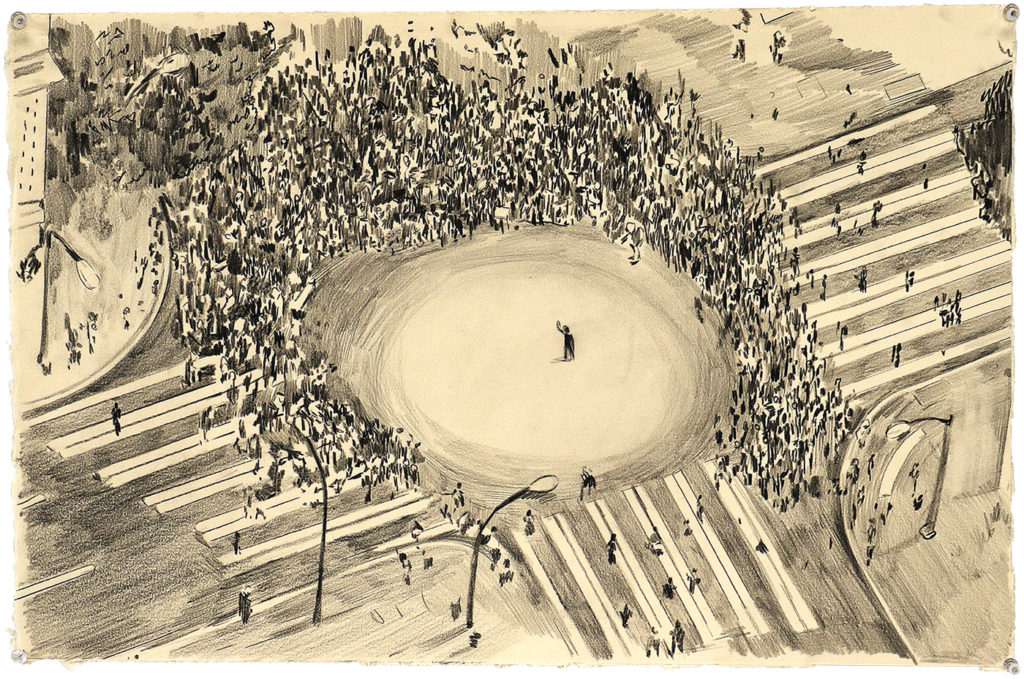 Heather Kai Smith, Destruction Proves its Existence, 2017. Charcoal-and-oil-based pencil drawing on BFK Rives paper, 35.6 x 55.9 cm.
Heather Kai Smith, Destruction Proves its Existence, 2017. Charcoal-and-oil-based pencil drawing on BFK Rives paper, 35.6 x 55.9 cm.
Heather Kai Smith worked associatively, using analogy and metaphor to explore specific forms such as the crowd, the mass, the party, the event. These forms developed from her interest in women’s gatherings, protests, collective organizing and resistance. In this way, her process allowed for a reconsideration of how language bears on research in the fields of art and physics while considering a specific concept and thereby illuminating that concept through her particular practice. For Smith, even the notion of a positron (i.e., an anti-electron) amplifies the world connection to a force of resistance in current movements for social justice: “Focusing on the topic and allowing myself time to consider a specific concept through my practice has illuminated my habits of thinking…I’m more interested in how to sit with a concept that might feel unnatural to me and observe where my associations lead.”
SECOND RELAY
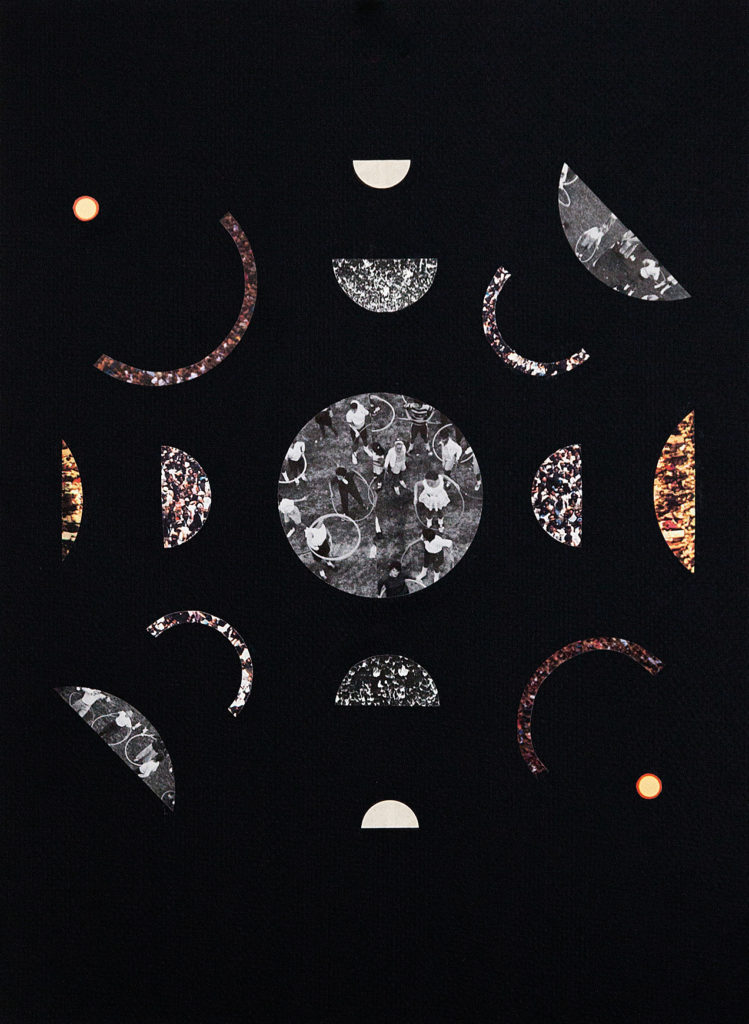 Maggie Groat, 4/7 fr HS > AY, 2017. Collage on salvaged images on paper, 38 x 28 cm.
Maggie Groat, 4/7 fr HS > AY, 2017. Collage on salvaged images on paper, 38 x 28 cm.
Maggie Groat responded to the visual language in Smith’s original drawings, and the concepts in physics that might be derived from them, as diagrammatic. Groat characterizes the process of her practice as also engaging associative thinking. After amassing a collection of found materials, she worked with invisible logic, flows of movement, time travel, ideas of black holes and other kinds of voids in the universe: “To not know something, and that that something is directly orbiting or anchoring what it is that you are doing, was a freeing place to be, in a way—while I was making the work I would stop and ask myself if one move or selection within the work ‘made sense’ and then I would laugh out loud because what could possibly be the measure of that logic?”
THIRD RELAY
Most often in collaborations, the given subject matter determines an aesthetic, but with the computer-generated sound piece Attractions and Compulsions, Andrea Young was free to associate using the previous images by Smith and Groat in concert with her imagination. Young’s ambient sound work moves through a range of “sonic landscapes,” from ethereal to static: sound dust, resonant waves, or sometimes with a searching quality, suggesting a scanner trying to pick up information or particles of sound not of this world. Playing with ideas of crowds, attraction, densities and compulsions, Young was inspired by materials and imagery to make her own metaphor, and worked abstractly to find less obvious undercurrents.
FOURTH RELAY
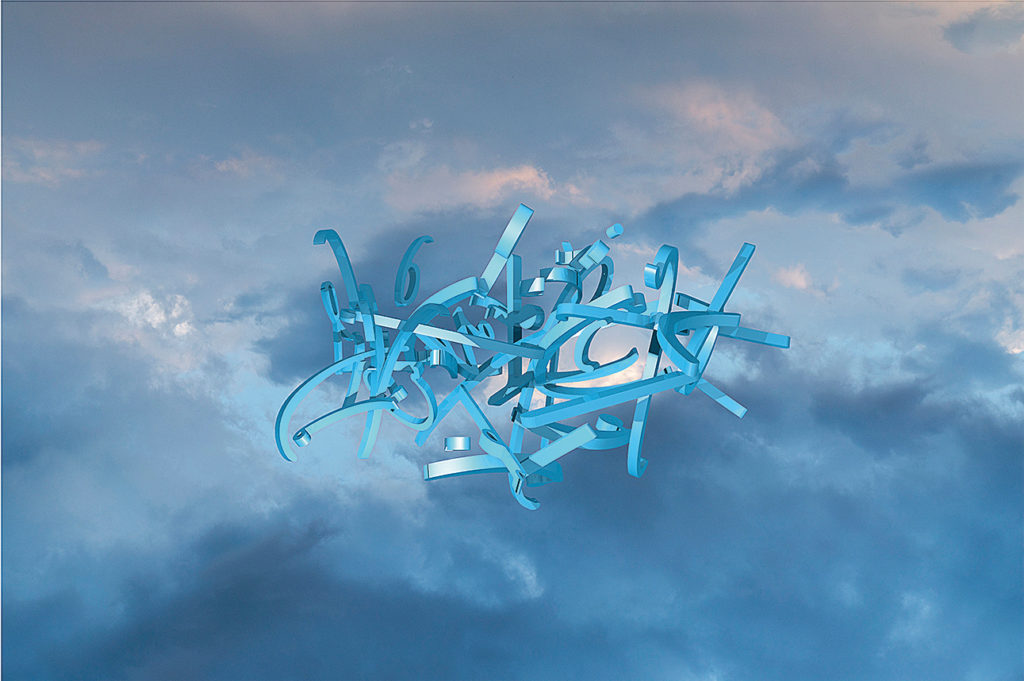 Robert Bean, a world of things is between those who have it in common (Hannah Arendt), 2017. Ink-jet print, 66 x 91.4 cm.
Robert Bean, a world of things is between those who have it in common (Hannah Arendt), 2017. Ink-jet print, 66 x 91.4 cm.
Robert Bean’s response to his unknown prompt is based on environments and acoustic spaces reminiscent of atmospheres. He draws on the concept of “air conditioning,” a term used by philosopher Peter Sloterdijk to explain how the atmosphere was made explicit as an environment through the use of gas warfare in the First World War. “I was very engaged by the works of the other artists as an art making process that was premised on uncertainty and an open game structure of guessing. Rather than try to strategically guess the specifics of the question originally posed, I responded through the artworks presented and the work I was currently pursuing through a metaphoric path of entanglement, playing the guessing game across the role of observer and observed.”
The “Dialogical Stream” brought together artists and scientists over an 11-week production period. Conversations and feedback loops with designated scientists occurred in a kind of metaphorical fishing trip: both artists and scientists received whatever ideas they might reel in, as they swirled around blocks and obstacles to reveal new routes or channels of exploration. Communication could take any form. The artists shared their work-in-progress to help elaborate on the science topic in any way that benefited the creative process. At the end of the production period, the artists transferred their artwork via a studio visit or a digital file to the next artist in the relay, and the process repeated.
FIRST RELAY
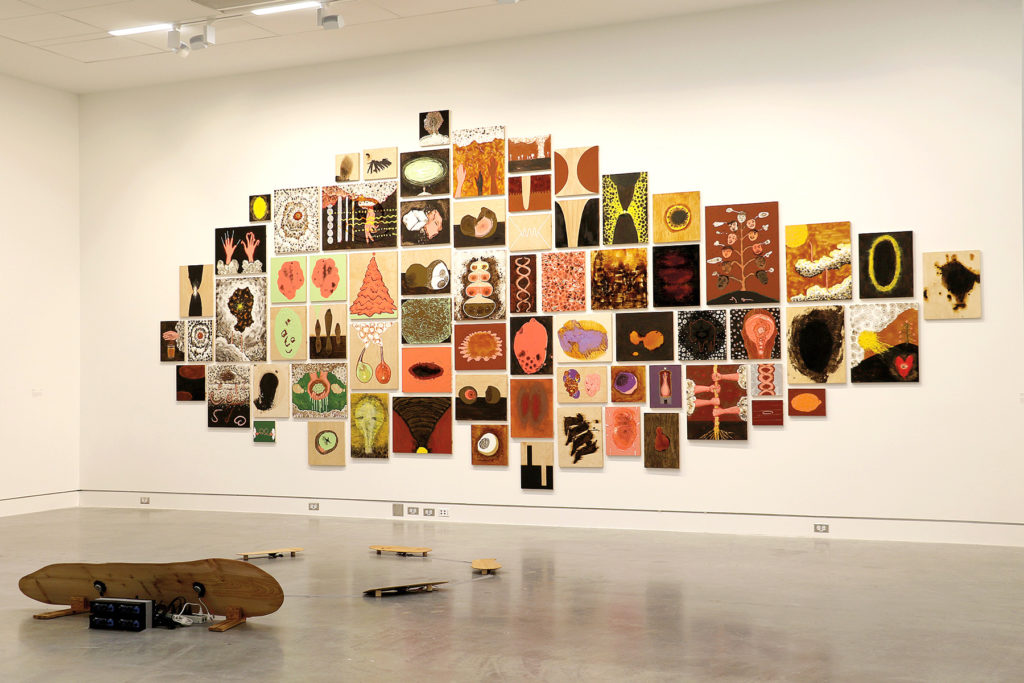 On floor: Giorgio Magnanensi, SOUND CRYSTALS / -H, 2017. Microsonic environment for variable sound clouds and maple flat audio resonators, dimensions variable. On wall: Marina Roy, Dirty Clouds, 2017. Installation with shellac, oil and acrylic paintings on wood panels, dimensions variable.
On floor: Giorgio Magnanensi, SOUND CRYSTALS / -H, 2017. Microsonic environment for variable sound clouds and maple flat audio resonators, dimensions variable. On wall: Marina Roy, Dirty Clouds, 2017. Installation with shellac, oil and acrylic paintings on wood panels, dimensions variable.
Giorgio Magnanensi’s work focuses on the sonic imagination. His assigned physicist, Art Olin, shared research into antimatter being conducted at CERN, where antihydrogen is synthesized. Magnanensi considered the audible chirps and the vibrations of plasma clouds generated from this process, and noticed an oscillation between antihydrogen and his own apprehension of its possible yet impenetrable existence as a fluid and shifting in-between space. This activated a flow of symbolic and poetic reveries, a metaphor for a crystallized resonance that Magnanensi describes as emerging from the anthropomorphic quality of perception.
SECOND RELAY
 Marina Roy, Dirty Clouds (detail), 2017. Shellac, oil and acrylic paint on wood panel.
Marina Roy, Dirty Clouds (detail), 2017. Shellac, oil and acrylic paint on wood panel.
Marina Roy is interested in reorganizing scientific ideas to aesthetically think through how material continues to disperse and flow. She does this with paint, mixing oil-based into water-based materials to symbolize a world understood according to material particles and waves of energy; the materials we see are the leftovers of billions of years of annihilation. Working with scientist Carla Babcock and driven by free association, Roy makes an analogy between antimatter and alchemy, bringing centuries-old human history into what is now considered an exact science, which does its best to do away with esoteric mysteries: “Thinking about how the origins of the universe continue from an infinitely dense singularity to its explosion where no light could penetrate, how do these origins continue to expand at the edges of the universe?”
THIRD RELAY
 Mimi Gellman, Invisible Landscapes, 2017. Conte on Japanese Obonai paper, 63.5 x 48.3 cm.
Mimi Gellman, Invisible Landscapes, 2017. Conte on Japanese Obonai paper, 63.5 x 48.3 cm.
Mimi Gellman’s conversations with physicist Brian Kootte ranged from topics covering the big bang to matter and antimatter to aesthetics and spirituality. They shared an interest in lateral thinking, unknowing and an appreciation for ambiguity. The drawings that evolved gather dialogic memories and scientific data with Ojibwe patterns and symbols of Ojibwe entities to form new narratives. They reflect a coming together of seemingly disparate worldviews that, in effect, are mere manifestations of different dialects: “The interior dimension explored in subatomic physics and the implicit interiority of contemporary art are no longer only about the representation of the exterior world but rather about exploring the architecture of consciousness.”
The third research stream, “Tandem,” had two artists and two physicists. The first artist, in dialogue with the other artist and the physicists, produced work that was then transferred to the second artist, who responded to the topic of antimatter and the first artist’s artwork. The two physicists had the opportunity to rephrase the topic, whether in the form of a conversation, a story, a drawing, etc. Each artist had the option to produce a second iteration of their artistic response while continuing to communicate with their “Tandem” group. Ingrid Koenig’s studio class “Leaning Into Quantum Fields” comprised the fourth stream, “Fieldwork.” Students gained practical experience and knowledge through first-hand observations of physics topics presented at the TRIUMF lab. Thought experiments were threaded throughout this stream as students excavated an idea, probed the forces of an unfamiliar language, conducted research and produced responsive artworks within a network. Quicker relays were built into their production period.
The process design for the most recent phase of Leaning Out of Windows was launched in September 2018, on the topic of Emergence. This next phase of 11 teams, made up of artists, scientists and other scholars, was organized into collaborative groups as a way to test and further activate associative thinking for comprehending complex phenomena, from different aesthetic and scientific perspectives. Still in process, we speculate that new ways of thinking will arise from this process of co-thought. Rather than seeking integration, we are interested in the idea of holding different insights, different ways of knowing in relationship. We envision this as an emergent, multifaceted phenomenon, encountered and evolving over time.
Parts of this article have been adapted from work previously published by The Centre for Imagination in Research, Culture and Education at Simon Fraser University. LOoW is an ongoing project with research distributed across various platforms including its website, leaningoutofwindows.org

 Ingrid Koenig, Antimatter Process Design (detail), 2017. This diagram shows the process design of five different streams of interactions, mapping out routes for 26 artists and 26 physicists, as well as an experimental class taught by Koenig at Emily Carr University of Art and Design.
Ingrid Koenig, Antimatter Process Design (detail), 2017. This diagram shows the process design of five different streams of interactions, mapping out routes for 26 artists and 26 physicists, as well as an experimental class taught by Koenig at Emily Carr University of Art and Design.
